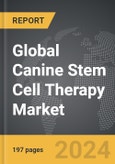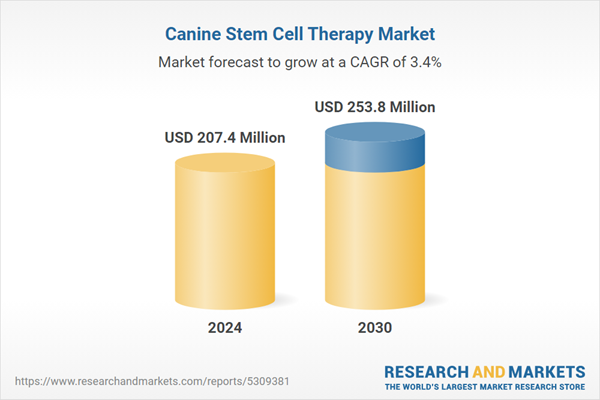The global market for Canine Stem Cell Therapy was valued at US$207.4 Million in 2024 and is projected to reach US$253.8 Million by 2030, growing at a CAGR of 3.4% from 2024 to 2030. This comprehensive report provides an in-depth analysis of market trends, drivers, and forecasts, helping you make informed business decisions. The report includes the most recent global tariff developments and how they impact the Canine Stem Cell Therapy market.
Segments: Type (Allogeneic Stem Cells, Autologous Stem Cells); End-Use (Veterinary Hospitals, Veterinary Clinics, Veterinary Research Institutes).
Geographic Regions/Countries: World; United States; Canada; Japan; China; Europe (France; Germany; Italy; United Kingdom; and Rest of Europe); Asia-Pacific; Rest of World.
The analysts continuously track trade developments worldwide, drawing insights from leading global economists and over 200 industry and policy institutions, including think tanks, trade organizations, and national economic advisory bodies. This intelligence is integrated into forecasting models to provide timely, data-driven analysis of emerging risks and opportunities.
Global Canine Stem Cell Therapy Market - Key Trends and Drivers Summarized
Why Is Canine Stem Cell Therapy Gaining Popularity in Veterinary Medicine?
Canine stem cell therapy has rapidly gained traction as a revolutionary treatment in veterinary medicine, offering hope for conditions that were once difficult to manage in dogs, particularly degenerative diseases, injuries, and immune disorders. Stem cells, especially those derived from a dog's own fat tissue (adipose-derived stem cells), have the unique ability to regenerate damaged tissues, reduce inflammation, and promote overall healing. This therapy is most commonly used to treat musculoskeletal conditions like osteoarthritis, hip dysplasia, and ligament injuries - ailments that cause significant pain and limited mobility in dogs, particularly as they age. Traditional treatments for these conditions, such as non-steroidal anti-inflammatory drugs (NSAIDs), physical therapy, or even surgical interventions, can offer temporary relief but often come with side effects or the risk of complications. Stem cell therapy, by contrast, offers a less invasive solution with the potential for longer-lasting results. It works by harnessing the body’s natural healing processes, making it a more holistic approach to treating conditions that affect a dog’s mobility and quality of life. As more veterinarians and pet owners recognize its benefits, the demand for canine stem cell therapy has grown, reflecting a broader shift toward advanced regenerative therapies in animal care.How Is Technology Advancing Canine Stem Cell Therapy?
The success and expanding reach of canine stem cell therapy are closely tied to rapid advancements in biotechnology and regenerative medicine. Over the past decade, significant progress has been made in how stem cells are processed and administered, improving the safety, efficacy, and convenience of these treatments for both veterinarians and pet owners. One major development is the refinement of methods for harvesting and processing adipose-derived stem cells, where stem cells can now be extracted, purified, and expanded in specialized laboratories with greater speed and precision. This allows for quicker treatment cycles and improved outcomes, as the quality and viability of the stem cells have a direct impact on their therapeutic potential. Additionally, the use of allogeneic stem cells, which are derived from donor animals, is an emerging trend, particularly for cases where it may not be feasible to collect stem cells from the patient. This approach broadens the availability of treatments, offering a solution even for dogs with underlying conditions that complicate autologous stem cell collection. Another significant advancement is in cryopreservation techniques, which allow harvested stem cells to be stored long-term and reused in future treatments without requiring repeated surgeries. These technological innovations, combined with the use of imaging technologies like MRI and ultrasound for precise targeting of stem cell injections, have made stem cell therapy not only more accessible but also more effective at addressing complex and chronic conditions.What Trends and Challenges Are Shaping the Canine Stem Cell Therapy Market?
Several key trends are shaping the rapid growth and evolution of the canine stem cell therapy market, driven largely by the increasing demand for non-invasive, regenerative treatments for pets. As pet owners become more informed about advanced veterinary care options, there is a growing preference for therapies that can deliver better outcomes with fewer side effects compared to conventional treatments. This trend aligns with a broader movement in the pet care industry toward holistic and integrative treatments, where the focus is on promoting overall wellness and addressing the root causes of conditions rather than just managing symptoms. Moreover, the expanding research and clinical evidence supporting the efficacy of stem cell therapy in treating degenerative joint diseases, such as osteoarthritis, has bolstered its credibility among veterinarians, further encouraging its adoption. However, despite these positive trends, the market faces several challenges. One of the main hurdles is the cost of treatment, which remains high for many pet owners, potentially limiting access to this advanced therapy. There is also a need for more regulatory oversight to ensure the consistency and quality of stem cell products, as variations in how stem cells are processed can impact their safety and effectiveness. Moreover, while stem cell therapy has shown promise in treating a variety of conditions, long-term studies are still needed to fully understand its potential and limitations. Despite these challenges, the increasing number of success stories and ongoing innovations in the field suggest that the future of canine stem cell therapy is bright.What Factors Are Propelling Growth in the Canine Stem Cell Therapy Market?
The growth in the canine stem cell therapy market is driven by several factors, including advancements in veterinary science, increased awareness of regenerative medicine, and the rising demand for minimally invasive treatment options for aging and injured dogs. A key driver of this growth is the increasing prevalence of chronic conditions such as osteoarthritis, hip dysplasia, and ligament injuries in dogs, particularly as pet lifespans increase due to improved healthcare. As dogs live longer, the need for treatments that can enhance their quality of life without relying on invasive surgery or long-term medications becomes more critical. Stem cell therapy provides a viable solution, offering regenerative benefits that can significantly improve mobility and reduce pain. Additionally, advancements in the processing and storage of stem cells, including cryopreservation and the use of allogeneic stem cells, have made the therapy more accessible to a wider range of veterinary practices, further driving its adoption. Consumer behavior also plays a significant role, as pet owners become more educated about the potential benefits of stem cell therapy and seek alternatives to traditional treatments for their pets. The increasing availability of stem cell therapy at veterinary clinics, coupled with partnerships between biotech companies and veterinary practices, is helping to commercialize the therapy and make it more mainstream. Furthermore, the rising interest in personalized veterinary care, where treatments are tailored to the specific needs of individual pets, continues to propel the market, as stem cell therapy offers a highly customizable approach to treating a wide range of conditions. With ongoing advancements in biotechnology and growing consumer interest, the canine stem cell therapy market is poised for sustained growth in the coming years.Report Scope
The report analyzes the Canine Stem Cell Therapy market, presented in terms of units. The analysis covers the key segments and geographic regions outlined below.Segments: Type (Allogeneic Stem Cells, Autologous Stem Cells); End-Use (Veterinary Hospitals, Veterinary Clinics, Veterinary Research Institutes).
Geographic Regions/Countries: World; United States; Canada; Japan; China; Europe (France; Germany; Italy; United Kingdom; and Rest of Europe); Asia-Pacific; Rest of World.
Key Insights:
- Market Growth: Understand the significant growth trajectory of the Allogeneic Stem Cells segment, which is expected to reach US$174.8 Million by 2030 with a CAGR of a 3.9%. The Autologous Stem Cells segment is also set to grow at 2.4% CAGR over the analysis period.
- Regional Analysis: Gain insights into the U.S. market, valued at $55.2 Million in 2024, and China, forecasted to grow at an impressive 3.3% CAGR to reach $40.6 Million by 2030. Discover growth trends in other key regions, including Japan, Canada, Germany, and the Asia-Pacific.
Why You Should Buy This Report:
- Detailed Market Analysis: Access a thorough analysis of the Global Canine Stem Cell Therapy Market, covering all major geographic regions and market segments.
- Competitive Insights: Get an overview of the competitive landscape, including the market presence of major players across different geographies.
- Future Trends and Drivers: Understand the key trends and drivers shaping the future of the Global Canine Stem Cell Therapy Market.
- Actionable Insights: Benefit from actionable insights that can help you identify new revenue opportunities and make strategic business decisions.
Key Questions Answered:
- How is the Global Canine Stem Cell Therapy Market expected to evolve by 2030?
- What are the main drivers and restraints affecting the market?
- Which market segments will grow the most over the forecast period?
- How will market shares for different regions and segments change by 2030?
- Who are the leading players in the market, and what are their prospects?
Report Features:
- Comprehensive Market Data: Independent analysis of annual sales and market forecasts in US$ Million from 2024 to 2030.
- In-Depth Regional Analysis: Detailed insights into key markets, including the U.S., China, Japan, Canada, Europe, Asia-Pacific, Latin America, Middle East, and Africa.
- Company Profiles: Coverage of players such as Animal Cell Therapies, Inc, Aratana Therapeutics, Inc., Cell Therapy Sciences, Magellan Stem Cells, MediVet Biologics, LLC and more.
- Complimentary Updates: Receive free report updates for one year to keep you informed of the latest market developments.
Some of the 47 companies featured in this Canine Stem Cell Therapy market report include:
- Animal Cell Therapies, Inc
- Aratana Therapeutics, Inc.
- Cell Therapy Sciences
- Magellan Stem Cells
- MediVet Biologics, LLC
- Okyanos
- Regeneus Ltd.
- Stem Cell Vet
- Vetbiologics
- VetMatrix
Tariff Impact Analysis: Key Insights for 2025
Global tariff negotiations across 180+ countries are reshaping supply chains, costs, and competitiveness. This report reflects the latest developments as of April 2025 and incorporates forward-looking insights into the market outlook.The analysts continuously track trade developments worldwide, drawing insights from leading global economists and over 200 industry and policy institutions, including think tanks, trade organizations, and national economic advisory bodies. This intelligence is integrated into forecasting models to provide timely, data-driven analysis of emerging risks and opportunities.
What’s Included in This Edition:
- Tariff-adjusted market forecasts by region and segment
- Analysis of cost and supply chain implications by sourcing and trade exposure
- Strategic insights into geographic shifts
Buyers receive a free July 2025 update with:
- Finalized tariff impacts and new trade agreement effects
- Updated projections reflecting global sourcing and cost shifts
- Expanded country-specific coverage across the industry
Table of Contents
I. METHODOLOGYII. EXECUTIVE SUMMARY2. FOCUS ON SELECT PLAYERSIII. MARKET ANALYSISIV. COMPETITION
1. MARKET OVERVIEW
3. MARKET TRENDS & DRIVERS
4. GLOBAL MARKET PERSPECTIVE
UNITED STATES
CANADA
JAPAN
CHINA
EUROPE
FRANCE
GERMANY
ITALY
UNITED KINGDOM
REST OF EUROPE
ASIA-PACIFIC
REST OF WORLD
Companies Mentioned (Partial List)
A selection of companies mentioned in this report includes, but is not limited to:
- Animal Cell Therapies, Inc
- Aratana Therapeutics, Inc.
- Cell Therapy Sciences
- Magellan Stem Cells
- MediVet Biologics, LLC
- Okyanos
- Regeneus Ltd.
- Stem Cell Vet
- Vetbiologics
- VetMatrix
Table Information
| Report Attribute | Details |
|---|---|
| No. of Pages | 197 |
| Published | April 2025 |
| Forecast Period | 2024 - 2030 |
| Estimated Market Value ( USD | $ 207.4 Million |
| Forecasted Market Value ( USD | $ 253.8 Million |
| Compound Annual Growth Rate | 3.4% |
| Regions Covered | Global |









